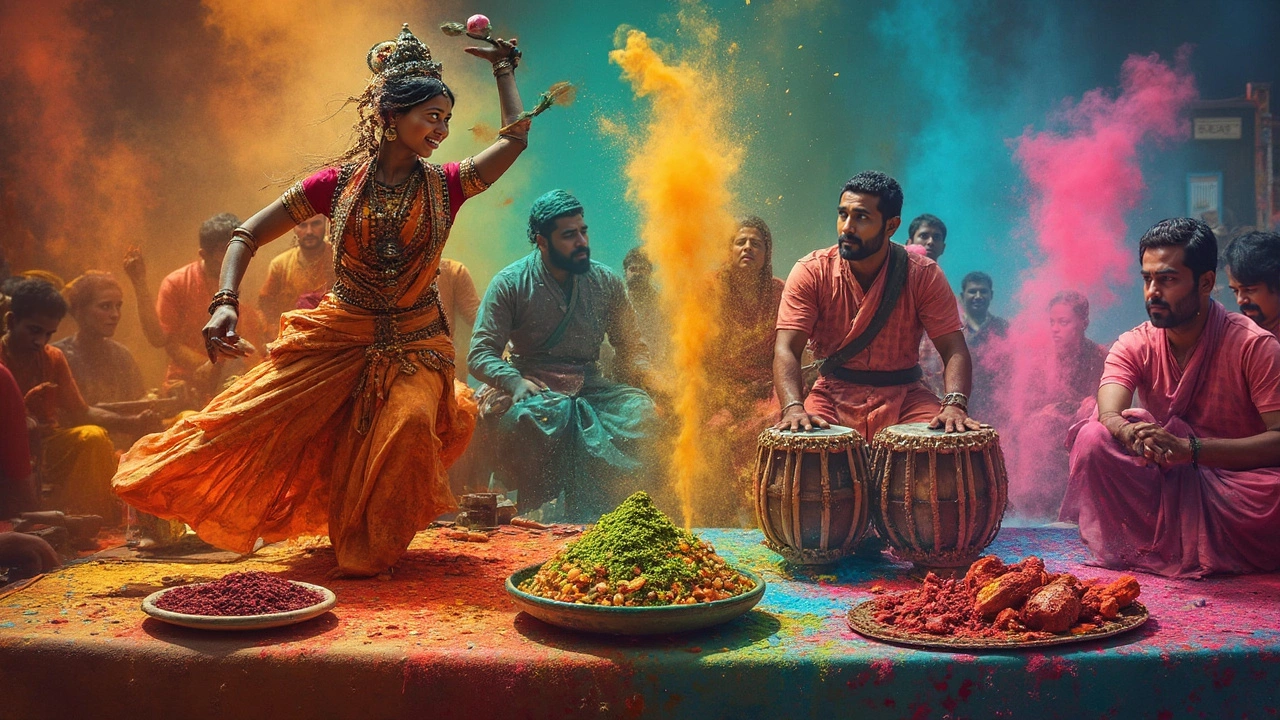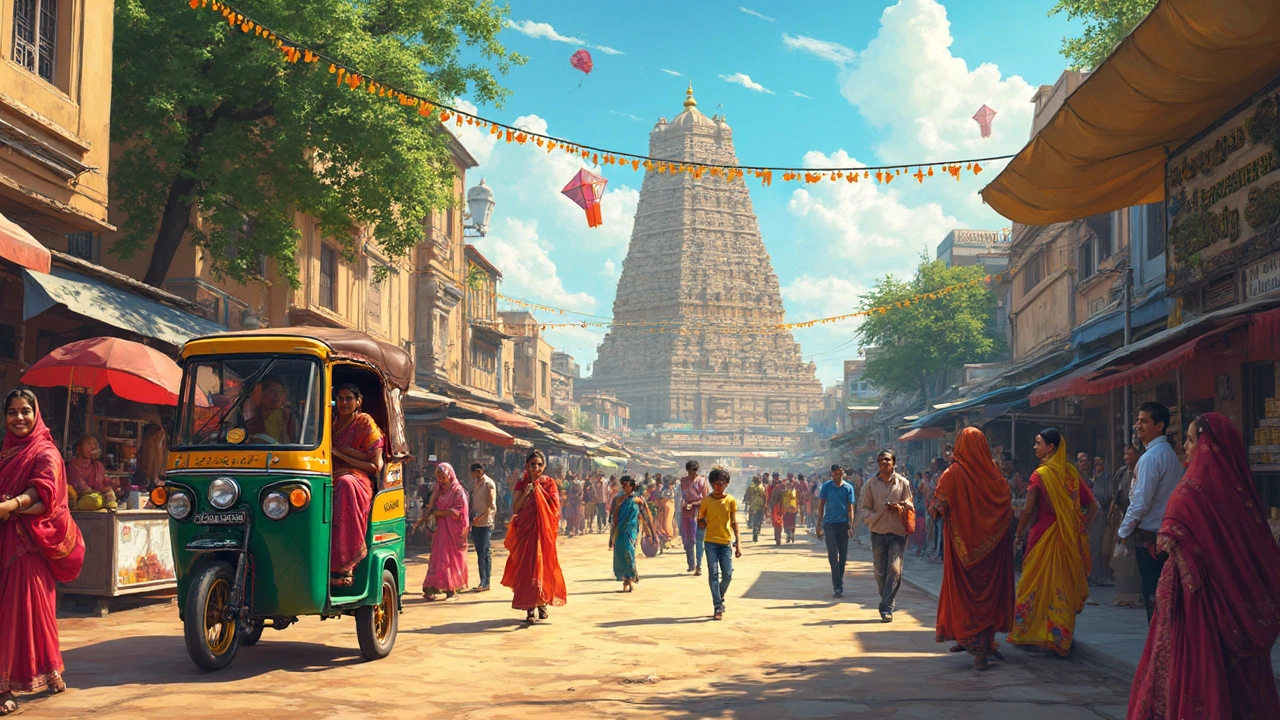People love to put things in boxes—especially when it comes to culture. Is it ‘high’ because it’s old or classy? Is it ‘low’ because it’s popular and everywhere? When it comes to India, these labels get messy fast. You can watch a hip-hop street performance steps away from ancient temple carvings. Kids stream Bollywood songs while their parents chant centuries-old hymns.
And here’s a wild fact: India has over 30 official festivals in just one calendar year. Some are massive, with crowds as large as a small city. Others—like a family quietly marking a harvest—go unnoticed by most outsiders. That’s not all: India’s street food scene is as famous as its classical dance. Both belong, both matter.
If you’re trying to figure out where Indian culture fits—up high, down low, or somewhere in between—get ready to toss out those neat categories. It’s time to see how India uses every trick in the book, blending ancient rituals with Netflix-inspired trends. What does ‘high’ or ‘low’ even mean here? Let’s break it down with simple facts, stories, and solid tips for actually experiencing the real thing.
- The Meaning of High and Low Culture
- India’s Classical Heritage: Temples, Arts, and Texts
- Pop Culture, Food, and Festivals: Where Tradition Meets Everyday Life
- Tips to Experience India’s Culture First-Hand
The Meaning of High and Low Culture
Alright, let’s clear up what these terms really mean. When people talk about “high culture,” they usually mean stuff that’s viewed as classy, fancy, or traditional—think classical music, ancient texts, fine arts, and old-school theater. “Low culture” is often what’s popular: trending music, blockbuster movies, street foods, and all those things that regular folks enjoy every day.
Here’s the thing—none of this is set in stone. Some people think of high culture like an exclusive club, but that’s not how real life works in places like India. Hundreds of millions tune in for Bollywood hits one day and follow age-old dance styles the next. Academic studies have even found that there’s more crossover today than ever, and both types shape how Indians live and celebrate.
Check out this quick comparison:
| Type | Examples in India | Where You'll Find It |
|---|---|---|
| High Culture | Classical music, temple sculptures, Sanskrit literature, Bharatnatyam dance | Museums, temples, concerts, festivals, textbooks |
| Low Culture | Bollywood movies, street food, pop music, TV soap operas, viral reels | Cinemas, markets, family homes, mobile phones |
But let’s not forget: what’s ‘low’ today can become treasured tomorrow. Did you know Indian street food has started getting international awards, and Bollywood has inspired fashion runways from Paris to New York?
Bottom line—Indian culture breaks all the old rules. It mixes and matches high and low, day in and day out. The best way to understand it? Don’t get stuck on labels—see how both sides work together and shape real life.
India’s Classical Heritage: Temples, Arts, and Texts
If you’re looking for ‘high culture’ in India, start with temples, centuries-old music, and the pile of ancient texts that shape everyday life. India’s oldest temples, like those at Khajuraho and Madurai, aren’t just pretty buildings—they’re working history, still used for rituals that go back over a thousand years. The Sanskrit inscriptions in places like the Brihadeeswara Temple blow away historians with their details. Ever see a dance performed as a prayer? That’s Bharatanatyam, which goes as far back as the 2nd century CE.
Classical Indian music is built with ragas and talas—basically blueprints for improvisation. Ravi Shankar (yep, George Harrison’s sitar teacher) once explained, “The music is based on something very ancient, but every note you play, you make it new.”
The Rigveda, one of India’s earliest texts (1500–1200 BCE), has been called the oldest religious text still in use today. – UNESCO Memory of the World Register
Want a snapshot of the main pieces that shape Indian classical heritage? Check this out:
| Heritage Element | Famous Example | Key Fact |
|---|---|---|
| Temples | Konark Sun Temple | Built in the 13th century, known for its stone chariot and solar alignment |
| Classical Dance | Bharatanatyam | UNESCO added it as an Intangible Cultural Heritage in 2009 |
| Texts | Bhagavad Gita | Translated into 80+ languages |
| Classical Music | Hindustani & Carnatic | Raga Yaman is taught as the starting point |
People think only scholars or artists care about the classics, but that’s not true in India. Even local festivals use verses from the Ramayana or Mahabharata. Schoolkids might not read the Vedas cover to cover, but hardly anyone grows up without hearing their stories. Here’s a tip: if you ever visit a temple, ask a local about the carvings—they’ll probably tell you a story you’ve never heard before. These traditions aren’t just in museums. They’re living, breathing, and still shaping what Indian culture means today.

Pop Culture, Food, and Festivals: Where Tradition Meets Everyday Life
What’s on everyone’s mind when they talk about India? Let’s be honest—it’s usually street food, Bollywood movies, and those jaw-dropping festivals that light up whole neighborhoods. But here’s what most people miss: these things aren’t just fun or flashy. They’re right at the heart of what makes Indian culture tick, blending old traditions with what’s trendy today.
Take Bollywood. Every year, the Indian film industry produces over 1,500 movies—way more than Hollywood. The songs you hear in rickshaws or shops come from these films, but many have roots in folk tunes or classical ragas. Modern beats, old-school melodies—nobody does mashups like this.
Now, about food. India’s got so many street snacks, entire books are dedicated to them. Think chaat in Delhi, vada pav in Mumbai, or idli in Chennai. Most of these came from local traditions, sometimes linked to holidays or temple fairs. Today, they’re quick bites you grab between a bus ride and your work shift. Local ingredients, time-tested recipes—but served up fresh on every street corner.
Festivals are where things explode. Just look at Diwali, Holi, or Ganesh Chaturthi: fireworks, colors, floats. Some states go all out—Goa’s Carnival is basically a party for the whole town, while Onam in Kerala has massive banana feasts and boat races. What’s wild? Many Indian companies now give time off for dozens of festivals, so people can actually join in. Here’s a quick look at some numbers behind the biggest Indian festivals:
| Festival | People Celebrating | Main Region |
|---|---|---|
| Diwali | Over 800 million | All India |
| Holi | 500 million+ | North, Central, West |
| Durga Puja | 100 million | West Bengal, East |
| Eid | 200 million | All major cities |
| Pongal | 60 million | Tamil Nadu |
So, how do you jump in if you want to get a taste of real Indian daily life?
- Watch a street-side Bollywood dance and don’t be shy to join for a move or two. Trust me, no one’s judging.
- Try eating with your hands at a street stall. Locals do it for a reason—it’s practical and connects you to what you’re eating.
- Mark your calendar for a major festival. Even if you’re not religious, these are the best entry point for anyone curious about Indian culture. The energy is infectious, tickets are cheap (or free), and everyone’s welcome.
- Don’t just visit big tourist spots. Sit in a neighborhood tea shop or hop on a city bus during festival season—this is how you see Indian culture in action, all around you.
This mix of tradition and what’s hot right now is what keeps India’s culture not just alive, but buzzing with new life every single day.
Tips to Experience India’s Culture First-Hand
India isn’t just something you watch from a distance. To really get it, you’ve got to step onto the street, into a temple, or even somebody’s kitchen. Here’s how you do it right, without missing the stuff that makes Indian culture truly stand out:
- Hit the Festivals: Don’t just read about Holi or Diwali—get out there. Even smaller, local festivals are loud, colorful, and friendly to visitors. Diwali alone lights up over 100 million homes each year. Call ahead or ask locals, as timing and customs can change by region.
- Eat Street Food (the Smart Way): India’s best snacks aren’t in fancy restaurants. Vendors in Delhi, Mumbai, Kolkata, and Chennai serve up chaat, samosas, dosas, and vada pav. Go where there’s a crowd and fast turnover; it means the food’s fresh. Always drink bottled water.
- Explore Different Arts: India has eight major classical dance forms, from Bharatnatyam to Kathakali, and dozens of music styles. Check schedules at large city theaters or see a smaller performance in a town hall. Even a wedding might feature traditional live music.
- Take a Heritage Walk: Major cities run guided walking tours that show off secret temples, old bazaars, and ancient stepwells—a surprising mix of the old and the new. Delhi and Ahmedabad both have famous heritage walk programs.
- Stay with Locals: Homestays are big in India now. Staying with a family, whether in Kerala’s backwaters or a Rajasthani village, gives you a real-life look at daily rituals, food habits, and celebrations most tourists never see.
To give you an idea of what’s going on during the year, here’s a quick snapshot of some top Indian festivals and how many people join in:
| Festival | Region | Estimated Participants |
|---|---|---|
| Diwali | All over India | Over 1 billion |
| Holi | North/Central India | 300 million+ |
| Onam | Kerala | 30 million |
| Durga Puja | West Bengal | 20 million in Kolkata alone |
| Pongal | Tamil Nadu | 15 million |
One last tip: forget any ideas that you’ll “cover India in a week.” Pace yourself, pick one region, and go deep instead of trying to see everything. Even people born in India are still discovering new bits of their own culture every day.
